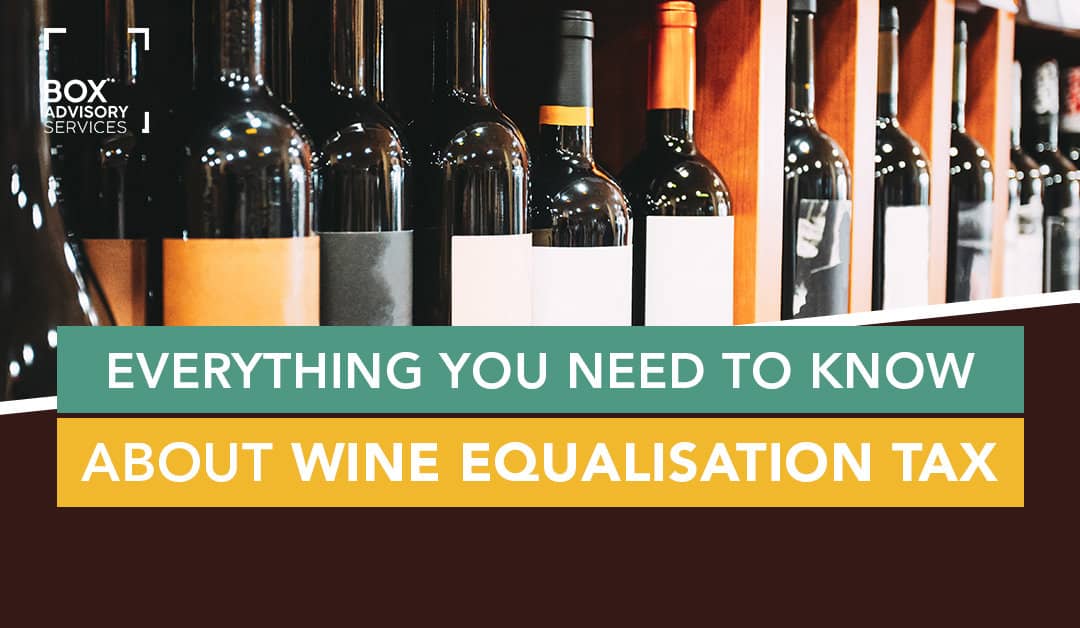
BY
|
Everything You Need to Know About Wine Equalisation Tax
Wine equalisation tax is levied on wine consumption in Australia.
Wine production makes up a considerable part of the agricultural industry, contributing over $45 billion annually to the Australian economy.,
What’s more, according to Wine Australia, the wine industry employs around 163,790 full and part-time employees across the 65 wine-growing regions.
Wine equalisation tax (WET) affects wine producers, wholesalers as well as importers. Fortunately, however, the Australian Tax Office (ATO) does allow a producer rebate.
If you’re new to the sale and purchasing of wine, the system can seem quite confusing.
So, we’ve decided to breakdown everything you need to know, including how much WET you have to pay, when it’s payable and when you’ll be exempt from paying wine equalisation tax.

What Is Wine Equalisation Tax?
According to the ATO, if you produce wine, import wine into Australia or sell wine wholesale, you’ll generally be liable to pay wine equalisation tax.
So, simply put, wine equalisation tax is a once-off tax payable if you deal with wine or sell it and is calculated on the taxable value of the wine.
Wine equalisation tax is levied at 29% of the wholesale value of wine, and you’ll generally only pay it if you’re registered for GST or when you’re required to be registered for GST.
GST calculated after WET is added to the price of the wine.
For example, for wholesale or distributor sales, you would apply the 29% wine equalisation tax rate to the sale price of the wine, then calculate GST on the WET-inclusive price.
So, wine equalisation tax and GST go hand in hand when calculating how much you’re going to end up selling or distributing your wine for.
If you’re in the business of importing wine into Australia, you’ll have to pay wine equalisation tax regardless of whether you’re registered for GST or not.
When Will You Have To Register For GST?
For contextual purposes, it’s worth noting that you have to register for GST if your business’s turnover exceeds the $75,000 GST threshold.
GST is calculated after wine equalisation tax is added to the price of the wine.
So, if you sell wine to a wholesaler, you would add the 29% wine equalisation tax to the sale price of the wine and then calculate GST on the WET-inclusive price.
What Products Does Wine Equalisation Tax Apply To?
Wine equalisation tax applies where the following beverages contain more than 1.15% by volume of ethyl alcohol:
- Grape wine: including sparkling and fortified wine that does not exceed 22% alcohol by volume
- Grape wine products: marsala, a fortified wine style, is considered an example of a grape wine product.
- Fruit wines and vegetable wines: any alcoholic beverage made from the complete or partial fermentation of fruit or vegetables other than grapes
- Cider and perry (pear cider): wine equalisation tax doesn’t apply to all ciders – see discussion below
- Mead: which is a honey wine made when fermenting honey and water
- Sake: which is an alcoholic beverage made by fermenting rice
Calculating Wine Equalisation Tax
Depending on the type of sale of the wine, there are different ways to calculate wine equalisation tax.
Wholesale Sales
To calculate wine equalisation tax on the wholesale of wine and wine products, you’ll use the following method:
Price for which goods are going to be sold x 29%
The WET amount must be shown on the buyer’s invoice to inform them that you’re liable to pay the wine equalisation tax.
In certain circumstances, the buyer of the wholesale can quote their Australian Business Number (ABN). If that is the case, the sale will be exempt from wine equalisation tax.
Another calculation method would be to use the average wholesale price.
The Average Wholesale Price Method
To calculate the average wholesale price using this method if at least 10% by value of all your grape wine sales are wholesale sales:
- of the same vintages; and
- produced from the same grape varieties or the same blend of grape varieties, during the tax period in which you’re liable to pay wine equalisation tax on the retail sale of your wine.
The calculation considers the average of the prices of the wholesale sales and the relative proportion of each type of wine you sell.
You’ll also take into account payments that reduce the wine’s selling price, such as:
- any discounts;
- incentives; and
- rebates (see discussion below).
Calculation: average wholesale price of wine sold x 29% = WET payable
Example:
At Maryland Wine Farm, 65% of the wine sales are to cellar door customers, and the remaining percentage is sold to distributors.
The different wholesale prices were as follows:
- $82 per 12 bottles to their cellar door customers
- $75 per 12 bottles to the distributors
The weighted average price of the wholesales per 12 bottles is:
(65% X $82) + (25% x $75) = $72,05
The winemaker then uses the following formula to calculate the wine equalisation tax payable:
$72,05 x 29% = $20.89
Therefore the amount of wine equalisation tax payable in this instance is $20.89.

Retail Sales
Retail sales include sales made to:
- the consumer directly (cellar door sales);
- wine clubs;
- bottle shops;
- hotels;
- restaurants and bars; and
- cafes.
To calculate wine equalisation tax on retail sales, you need to determine the notional wholesale selling price – the taxable value on retail sales.
The Half Retail Price Method
Calculate 50% of the retail price (WET and GST-inclusive) to establish the notional wholesale selling price. Then you’ll multiply the amount by 29% to determine the wine equalisation tax payable:
50% x retail selling price = notional wholesale selling price (i.e. taxable value)
Notional wholesale selling price x 29% = WET payable
Example:
Luna Wine Farm sells its wine to consumers directly from their wine farm (i.e. cellar door sales).
If they sold 12 bottles of Sauvignon Blanc to a customer for $142 (GST inclusive), Luna Wine Farm will calculate the wine equalisation tax as follows:
50% x $142 = $71
$71 x 29% = $20.59Therefore the amount of wine equalisation tax payable in this instance is $20.59.
Wine Equalisation Tax and the Type of Sale
The table below summarises how wine equalisation tax is payable on each type of wine sale or transaction:
| Type of sale | Does the customer get charged WET? | Calculation Method |
| Cellar door sale directly to the customer | Yes | Half price method or average wholesale method |
| Wholesale with a valid ABN quotation from the buyer | No | – |
| Wholesale without a valid quotation | Yes | Price for which wine is going to be sold x 29% |
| Retail Sale (if it hasn’t already been a wholesale sale where WET was payable) | Yes | Price for which wine is going to be sold x 29% |
| Wine for own use (if it hasn’t already been a wholesale sale where WET was payable) | Yes | Half price method or average wholesale method |
Wine Producer WET Rebate
The ATO allows wine producers to claim a wine equalisation tax rebate (or tax credit) on the amount they have paid on a wine dealing or the amount of WET they would have paid on the dealing if the buyer did not quote their ABN.
The producer rebate scheme applies to all products subject to WET, whether sold by wholesale, retail, or applied to own use.
Different eligibility criteria apply to the wine equalisation tax rebate depending on when the winemaking process started.
The following eligibility criteria apply to wine sold or dealt with from 1 July 2018:
- you must be the producer of the wine;
- you’re liable to pay wine equalisation tax or sell the wine under quote to a wine buyer;
- you must own the grapes or other source products ( for example, if you’re making mead, you must own the honey); and
- you sell the wine in a container with a 5-litre capacity or less that is suitable for retail sale and branded with a trademark owned by you (or the wine-producing company)
From 1 July 2018, the maximum producer rebate that can be claimed each financial year is $350,000.
For eligibility criteria that apply to 2017 and earlier vintages, check out the ATO’s website.
Key Takeaways
Wine equalisation tax is a 29% tax levied on the sale of wine or any other dealings with wine in Australia.
If you’re a wine producer in Australia, here’s what you need to know:
- wine equalisation tax applies to a variety of wine-type beverages that contain more than 1.15% by volume of ethyl alcohol;
- there are two methods you could use to calculate the wine equalisation tax payable: the average wholesale price method and the half-price retail method; and
- you could qualify to claim a $350.00 wine equalisation tax rebate if you meet certain eligibility criteria
While this article aimed to give you a foundational understanding of the wine equalisation tax, paying it could get a bit tricky because there are various methods and buyers involved in the process.
To ensure that you’re meeting your wine equalisation tax requirements, you may wish to consult with a qualified tax agent.
If you’re feeling unsure about paying wine equalisation tax, you can reach out to us at Box Advisory Services.
Simply book a FREE consultation with us or give us a call to discuss how to meet your tax obligations.
Disclaimer:
Please note that every effort has been made to ensure that the information provided in this guide is accurate. You should note, however, that the information is intended as a guide only, providing an overview of general information available to property buyers and investors. This guide is not intended to be an exhaustive source of information and should not be seen to constitute legal, tax or investment advice. You should, where necessary, seek your own advice for any legal, tax or investment issues raised in your affairs.




